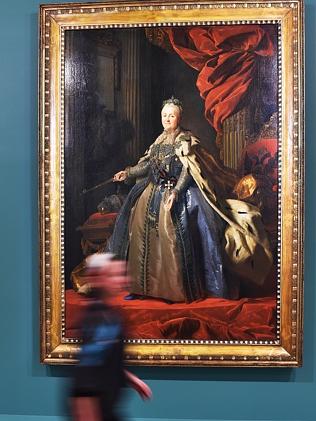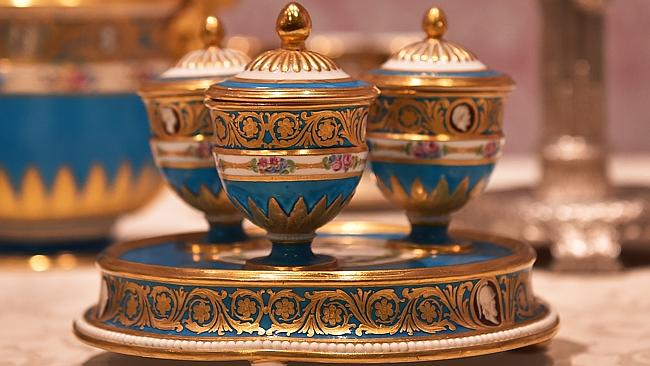Since it was first opened to the world in 1852, Catherine the Great’s remarkable collection of treasures has attracted art lovers across the world, with more than three million visiting the State Hermitage Museum in St Petersburg.
The three-million strong collection which is housed in six buildings, anchored by the 1,000 room Winter Palace, was founded by the empress of Russia’s Golden Age after she purchased a small collection from a Berlin dealer in 1764. Astonishingly, her vast collection was built, Dedinkin says, in just three decades.
Masterpieces from the Hermitage: the Legacy of Catherine the Great, features works by artists such as Rembrandt, Rubens, Velazquez and Titian/ The art show is a coup for the National Gallery of Victoria (NGV) as it is one of the biggest shows the Hermitage has ever sent outside the Russian Federation.
NGV director Tony Ellwood said, showcasing work collected by Russia’s empress Catherine the Great during a 30-year period from 1763, had been specially curated for Melbourne by Dr Dedinkin.
The NGV’s senior curator of international art, Dr Ted Gott, said each work would be thoroughly examined and assessed four times during the exhibition process: leaving Russia, on arrival in Australia, and then again at each location for the return. About 10 Hermitage curators and conservators have been responsible for the inspections.
Each examination involves putting a work under arc lights and going over it millimetre by millimetre, checking it against photographs and written descriptions.

The exhibition includes not only paintings prized by visitors to the Hermitage, but a large collection of works on paper, architectural drawings and one of Catherine’s favourite treasures: 60 pieces from a cameo service that is part of a much larger 700-plus set held at the museum.
According to Sharon Verghis, who viewed Catherine the Great’s collection in situ in St Petersburg:
The exhibition design in Melbourne is planned to mirror the richness of the Hermitage. Visitors will first see the magnificent life-size portrait of Catherine by Alexander Roslin before moving into rooms dedicated to her architectural drawings, her cameo collection, the Cameo Service, different schools of paintings, as well as a room devoted solely to pieces from the Walpole collection, before moving into a final room filled with her chinoiserie collection.
One glorious room is dedicated to Catherine’s collection of Italian masters. Another celebrates her enviable array of Dutch and Flemish art. Then there’s the “Chinese room’’, sparkling with pearly pleasures from the Orient. Quality shines from every corner. These truly are jewels in the museum’s crown. And having recently visited the Hermitage, I can vouch for the accuracy of colours, light fixtures and floor patternings in the NGV show.
Masterpieces from the Hermitage is every bit as rich as the original … and tells a fascinating story. This exhibition is more focused than last year’s Italian Masterpieces from the Prado and for sheer dazzle is only matched, in my view, by the gallery’s 2009 Melbourne Winter Masterpieces show about Salvador Dali. Here, under the one roof, are 450 objects from Catherine’s personal collection at the Hermitage Museum in St Petersburg — from teaspoons and toiletries to Rembrandt’s and a School of Da Vinci. It’s a rich bounty, gleaming with all the glories of the tsarina’s 18th-century court, and easily navigable as one lavishly appointed gallery gives onto the next.

Transporting more than 500 works of art from Russia’s famous Hermitage Museum to Melbourne is an art in itself. Canberra Times reports that it was one of the most complex logistics operations the St Petersburg museum has undertaken, the art treasures – ranging from enormous genre paintings to small pieces of fragile crockery – arrived in several consignments and were this week unpacked and installed.
Senior Hermitage curator Dr Mikhail Dedinkin says, it is the strongest assembly of art the museum, one of the oldest and most famous in the world, has arranged. Packing began in St Petersburg several weeks ago and the Hermitage, in partnership with Art Exhibitions Australia and the NGV, has sent the consignments via land and sea routes that have taken up to five days to get here.
NGV director Tony Ellwood said moving such precious items was very complex and took sophisticated planning, with insurance and the value of items determining how their delivery was sequenced. “For a show of this scale you could appreciate it is incredibly labour-intensive and requires very good planning, and the flow of works has to be managed carefully as well,” he said.
This exclusive Melbourne exhibition will also highlight the innovation and vision of Catherine the Great, whose inexhaustible passion for education, the arts and culture heralded a period of enlightenment in the region. The extraordinary works sourced and commissioned by Catherine during her thirty-four year reign, created the foundations for the Hermitage today – considered to be one of the world’s greatest treasure houses of art and decorative arts.
The exhibition will offer audiences an immersive experience, recreating the rich atmosphere of the Hermitage to showcase these exquisite works.
Sources: SMH, CT, The Australian, NGV




